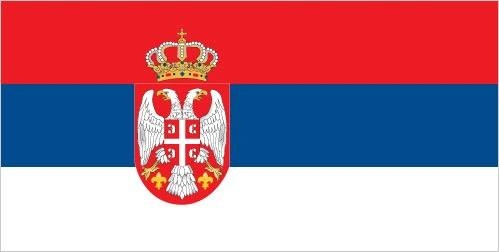107 Serbia

Three equal horizontal stripes of red (top), blue, and white – the Pan-Slav colors representing freedom and revolutionary ideals. Charged with the coat of arms of Serbia shifted slightly to the hoist side. The principal field of the coat of arms represents the Serbian state and displays a white two-headed eagle on a red shield. A smaller red shield on the eagle represents the Serbian nation, and is divided into four quarters by a white cross. Interpretations vary as to the meaning and origin of the white, curved symbols resembling firesteels (fire strikers) or Cyrillic “C’s” in each quarter. A royal crown surmounts the coat of arms.
Flag courtesy of the CIA World Factbook

Map courtesy of the CIA World Factbook

Smederevo Fortress, located 45 km (28 mi) southeast of Belgrade, is in the center of Smederevo city. The fortification was built between 1427 and 1439 as a temporary capital of Serbia during the Middle Ages after Belgrade was given to the Hungarians. The triangular shape of the fortress derives from its location at the confluence of the Jezava and Danube Rivers.
Photo courtesy of the CIA World Factbook
Government
According to Britannica, for more than four decades after the Partisan victory of 1945, Yugoslavia functioned as a communist federation. Its political evolution during the long presidency of Josip Broz Tito included the adoption of new constitutions in 1946, 1953, 1963, and 1974. After Slovenia, Croatia, Bosnia and Herzegovina, and Macedonia declared independence in 1991–92, Serbia and Montenegro adopted a new constitution in 1992 that created a Yugoslav federal union comprising the two republics. However, that new constitution lasted little more than a decade. In the late 1990s there was widespread support in Montenegro for independence, though the EU and the United States voiced disapproval. In 2002, shortly before a planned referendum on independence, Montenegrin leader Milorad Djukanović negotiated an agreement (under the auspices of the EU) with Serb and Yugoslav authorities that called for greater autonomy for Montenegro in a continued loose federation with Serbia named Serbia and Montenegro. Most governmental powers under the new constitution, ratified in 2003, were reserved to the two republics, though foreign policy, defense, and individual rights fell under federal statutes. In June 2006 this federation was dissolved, as Montenegro achieved its independence. Serbia, meanwhile, continued as a successor state to the former federation of Serbia and Montenegro.
Serbia’s head of state is the president, who is selected by the National Assembly but whose powers are marginal. Serbia’s parliament consists of 250 members directly elected by the public.
The Serbian republican government lost direct control over the autonomous provinces of Kosovo and the Vojvodina in 1968, when they were placed under federal authority. But over the following decades Albanians began to press for full republic status within Yugoslavia, which elicited an emotional counter reaction from Serbs, especially regarding Kosovo. The Serbs were particularly distressed at what were perceived to be pressures forcing the shrinking Serb minority to emigrate from Kosovo. In 1989 Serbia reasserted its direct control over Kosovo and the Vojvodina, which led to increased tensions that eventually erupted into armed conflict. In 1999 NATO began a 77-day bombing campaign against Yugoslavia in response to increasing violence against its Albanian population; subsequently, the Yugoslav government agreed to remove its security forces from Kosovo. The United Nations Mission in Kosovo (UNMIK) then took over the administration of the territory. The Vojvodina regained nominal autonomous status in 2002, but some local groups continued to call for a more extensive form of self-rule. In 2008 Kosovo declared independence; although the United States and most countries of the EU recognized the new country, Serbia denounced the declaration as illegal.
Local governments in Serbia’s communes (opštini) serve as basic units for services and tax collection. These communes are roughly 150 square miles (400 square km) in area, with an average population of 45,000. Urban communes have larger populations, many containing more than 100,000 inhabitants. The Basic Organization of Associated Labour chapters report to local commune assemblies and also elect representatives to them.
Civil Aviation Directorate
Airspace
SkyVector – Google Maps – ADS-B Exchange
ICAO countries publish an Aeronautical Information Publication (AIP). This document is divided into three parts: General (GEN), En Route (ENR) and Aerodromes (AD). ENR 1.4 details the types of airspace classes they chose to adopt from classes A through G.
SMATSA
Drone Regulations
Advanced Air Mobility (AAM) Regulations & Policies
None found by the author.
However, should you, the reader, happen to stumble across something to the contrary, please email the author at FISHE5CA@erau.edu and you may be mentioned in the ACKNOWLEDGEMENTS section of this book by way of thanks for contributing to this free eBook!
Advanced Air Mobility (AAM) News
2025 – Serbian government “plans to buy eVTOLs for first operations in 2027”
Short Essay Questions
Scenario-Based Question
You have been hired by a Drone Startup Company. Your boss has immediately assigned this job to you.
They need you to prepare a one-page memo detailing the legalities of using a drone to film in Belgrade, pictured above.
They need you to mention any national laws and local ordinances.
They specifically want to know what airspace (insert pictures) you will be operating in and whether or not you need an airspace authorization.
Does it matter whether or not you are a citizen of the country?
Lastly, there is a bonus for you if, as you scroll through this chapter, you find any typos or broken links!
Short Essay Questions
- What are the drone categories?
- How is registration addressed?
- How is remote ID addressed?
- What are the model aircraft rules?
- What are the commercial drone rules?
- Are there waivers or exemptions to the rules? If so, for what?
- Would you share a link to an interactive airspace map?
- How is BVLOS addressed?
- How can you fly drones at night?
- How can you fly drones over people?
- Where do you find drone NOTAMs?
- What are the rules for drone maintenance?
- What are the rules for an SMS program?
- What are some unique rules not mentioned above?
- What are the C-UAS rules?
- What are the AAM rules?

